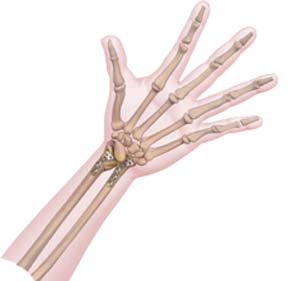
What is a Wrist Fracture?
The wrist is comprised of two bones in the forearm, the radius and ulna, and eight tiny carpal bones in the palm. The bones meet to form multiple large and small joints. A wrist fracture refers to a break in one or more of these bones.
Types of Wrist Fractures
The types of wrist fracture include:
- Simple wrist fractures, in which the fractured pieces of bone are well aligned and stable
- Unstable fractures, in which fragments of the broken bone are misaligned and displaced
- Open (compound) wrist fractures, which are severe fractures in which the broken bones cut through the skin. This type of fracture is more prone to infection and requires immediate medical attention.
Causes of Wrist Fractures
Wrist fractures may be caused by a fall on an outstretched arm, vehicular accidents or workplace injuries. Certain sports such as football, snowboarding or soccer may also be a cause of wrist fractures. Wrist fractures are commonly associated with osteoporosis, a condition marked by brittleness of the bones.
Signs and Symptoms of Wrist Fractures
The common symptoms of a wrist fracture include severe pain, swelling, and limited movement of the hand and wrist. Other symptoms include:
- Deformed or crooked wrist
- Bruising
- Numbness
- Stiffness
Diagnosis of Wrist Fractures
Your doctor performs a preliminary physical examination followed by imaging tests such as an X-ray of the wrist to diagnose a fracture and check the alignment of the bones. Sometimes a CT scan may be ordered to gather more details of the fracture, such as soft tissue, nerves or blood vessel injury. MRI may be performed to identify tiny fractures and ligament injuries.
Your doctor will order a bone scan to identify stress fractures due to repeated trauma. The radioactive substance injected into the blood gets collected in areas where the bone is healing and is detected with a scanner.
Treatment for Wrist Fracture
Your doctor may prescribe analgesics and anti-inflammatory medications to relieve pain and inflammation caused by a wrist fracture.
Fractures that are not displaced are treated with either a splint or cast to hold the wrist in place.
If the wrist bones are displaced, your surgeon may perform fracture reduction to align the bones. This is performed under local anesthesia. A splint or a cast is then placed to support the wrist and allow healing.
Surgery is recommended to treat severely displaced wrist fractures and is carried out under the effect of general anesthesia. Some of the common surgeries may include:
- External fixation, such as pins may be used to treat the fracture from the outside. These pins are fixed above and below the fracture site and are held in place by an external frame outside the wrist.
- Internal fixation may be recommended to maintain the bones in proper position while they heal. Devices such as rods, plates and screws may be implanted at the fracture site.
- Bone grafts may be used to treat crushed or missing bone. These are taken from another part of your body, bone bank or using a bone graft substitute.
Rehabilitation for Wrist Fracture Surgery
During the healing period, you may be asked to perform some motion exercises to keep your wrist flexible. Your doctor may recommend hand rehabilitation therapy or physical therapy to improve function, strength and reduce stiffness.
Risks and Complications of Wrist Fracture Surgery
As with any procedure, wrist fracture surgery may involve certain risks and complications such as:
- Infection
- Residual joint stiffness
- Arthritis

